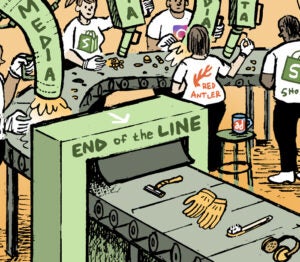 “The Sell Sider” is a column written by the sell side of the digital media community.
“The Sell Sider” is a column written by the sell side of the digital media community.
Today’s column is written by Alex Magnin, chief revenue officer and partner at The Thought & Expression Co.
Over the past two years, we’ve seen a wide variety of publishers get into the branded content game. Native ad spending on publisher properties is projected to hit $3.2 billion this year, before topping $9 billion in 2018.
Publishers like branded content because it draws value from their brand equity, some of which has been lost to audience-targeted banner ads, and it gives advertisers a hope of breaking through the clutter to actually impact their potential customers.
But the rising tide of branded content hides a lot under the surface. Making content that works well for both a user and an advertiser is more difficult than the industry is willing to admit. Today, we are papering over the problem with vanity metrics, but as a competitive landscape accelerates client understanding, eventually the tide will turn.
Rising Metrics
Today, page or video views are the overriding measure of success for branded content. During the past three years, the expectations for views have escalated. In the Federated Media days, publishers guaranteed zero or few views on a branded post or video. They were priced as a fixed fee, on distribution or as a value-add to a media campaign.
As native-focused ad networks and social-focused publishers rose, branded content became more common and agencies could compare publishers. Naturally, publishers began to guarantee performance to win deals. Two years ago, that guarantee might be 20,000 or 30,000 page views per piece. Now, 100,000 views or more is often the price of entry.
Of course, even a large publisher isn’t getting 100,000 page views on any given post, much less one that’s been melded with a brand. Now, publishers reserve a portion of the budget to market the branded content for views – sometimes on Facebook or Taboola, others on networks of less repute. There’s no breakout for “proprietary” or “organic” distribution. It all looks the same to the client.
The result is that at the right price, no publisher can provide more distribution than any other. If views are the big measure of branded content success, there will be a race to the bottom.
Challenges To the Pricing Structure
Even with a healthy budget for paid distribution, most branded content doesn’t have the magic to go viral and reach millions. And for the 98% of branded content that doesn’t hit “Dear Kitten” levels, the CPM for the advertiser can be well upward of $100. Publishers can’t lower their costs too much because there is significant overhead. Yet compared to a $20 basic cable ad spot, it’s doubtful a $250 branded content CPM is effective.
To date, branded content has been a place where otherwise-pressured publishers could engineer some margin. But with increased competition, including the rise of scaled influencer marketing, along with more experienced advertisers, some of that sweetness will be squeezed out of the market.
Likely Outcomes
Branded content does have a place in the future, particularly for publishers with strong brands. This is the age of digital media “going pro,” and branded content will follow suit.
The standard “listicle and a logo” will go out of style. The economics of getting reach and awareness this way won’t end up working for either side. We’ll see more branded content sold on a cost-per-view basis, at reasonable CPMs. Other metrics will be emphasized, like brand awareness and organic and second-level sharing.
Native ad networks will look like banner ad networks with much better creative optimization, and the CPMs will decline. Data targeting and the ability to reach a specific user with sequenced content will be standard offerings.
We will see fewer, but bigger, programs, and more competition for branded content placements with global-level reach, like on Snapchat or ESPN. There will be a premium on the potential for magic virality and the small handful of creative companies that can consistently produce it, such as BuzzFeed.
But for the average publisher, the tide will recede on branded content, leaving us with a much more competitive, lower-margin world.
Follow Alex Magnin (@alexmagnin), Thought Catalog (@thoughtcatalog) and AdExchanger (@adexchanger) on Twitter.












